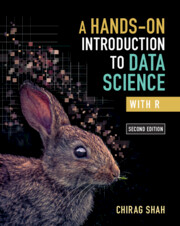Refine search
Actions for selected content:
1000 results

A Hands-On Introduction to Data Science with R
- Coming soon
-
- Expected online publication date:
- January 2026
- Print publication:
- 31 January 2026
-
- Textbook
- Export citation

A Hands-On Introduction to Data Science with Python
- Coming soon
-
- Expected online publication date:
- December 2025
- Print publication:
- 22 January 2026
-
- Textbook
- Export citation
4 - Varieties of Expertise
-
- Book:
- Negotiating Values
- Published online:
- 30 November 2025
- Print publication:
- 18 December 2025, pp 76-99
-
- Chapter
- Export citation
Chapter 9 - Statistical Modelling of Syntactic Complexity of English Academic Texts Using Ensemble Machine Learning
-
-
- Book:
- Data-Intensive Investigations of English
- Published online:
- 03 December 2025
- Print publication:
- 18 December 2025, pp 227-257
-
- Chapter
- Export citation
Symbolic identification of tensor equations in multidimensional physical fields
-
- Journal:
- Journal of Fluid Mechanics / Volume 1024 / 10 December 2025
- Published online by Cambridge University Press:
- 02 December 2025, A34
-
- Article
- Export citation
Physics of the vortex gust–airfoil interaction under an optimal mitigation strategy learned through deep reinforcement learning
-
- Journal:
- Journal of Fluid Mechanics / Volume 1024 / 10 December 2025
- Published online by Cambridge University Press:
- 01 December 2025, A18
-
- Article
- Export citation
Global trends and future projections of eating disorders among adolescents and young adults: comprehensive analysis from 1990 to 2050 using eight machine-learning models
-
- Journal:
- The British Journal of Psychiatry , FirstView
- Published online by Cambridge University Press:
- 27 November 2025, pp. 1-15
-
- Article
-
- You have access
- Open access
- HTML
- Export citation
Neural operator-based stochastic forcing for resolvent prediction of space–time turbulence statistics in channel flows
-
- Journal:
- Journal of Fluid Mechanics / Volume 1024 / 10 December 2025
- Published online by Cambridge University Press:
- 25 November 2025, A1
-
- Article
- Export citation
Only-child matching penalty in the marriage market
-
- Journal:
- Journal of Demographic Economics , First View
- Published online by Cambridge University Press:
- 24 November 2025, pp. 1-35
-
- Article
-
- You have access
- Open access
- HTML
- Export citation
10 - The Future of Chilling Effects and How to Stop It
- from Part III - Implications
-
- Book:
- Chilling Effects
- Published online:
- 20 November 2025
- Print publication:
- 20 November 2025, pp 168-189
-
- Chapter
- Export citation
Jurisprudence and the Intelligible World: Exploring Predictive Modelling as a Mechanism to Decide Bail in the Australian Context
-
- Journal:
- International Annals of Criminology , First View
- Published online by Cambridge University Press:
- 20 November 2025, pp. 1-37
-
- Article
-
- You have access
- Open access
- HTML
- Export citation
Frequency and bandwidth reconfigurable MIMO dielectric resonator antenna and its optimization using Taguchi neural network
-
- Journal:
- International Journal of Microwave and Wireless Technologies , First View
- Published online by Cambridge University Press:
- 14 November 2025, pp. 1-16
-
- Article
- Export citation
Multimodal prediction of psychotic-like experiences using elastic net modeling: external validation in a clinical sample
-
- Journal:
- Psychological Medicine / Volume 55 / 2025
- Published online by Cambridge University Press:
- 14 November 2025, e346
-
- Article
-
- You have access
- Open access
- HTML
- Export citation
Implementation of support vector machines to classify abnormal neuronal response during emotion regulation at an individual level in patients with newly diagnosed bipolar disorder – and its association with subsequent functional changes and mood episodes
-
- Journal:
- Psychological Medicine / Volume 55 / 2025
- Published online by Cambridge University Press:
- 11 November 2025, e338
-
- Article
-
- You have access
- Open access
- HTML
- Export citation
Training, fieldwork and collaboration in a new remote sensing method for heritage monitoring in Libya
-
- Journal:
- Libyan Studies , First View
- Published online by Cambridge University Press:
- 11 November 2025, pp. 1-11
-
- Article
-
- You have access
- Open access
- HTML
- Export citation
Early prediction of ADHD symptoms from perinatal characteristics: A machine learning study
-
- Journal:
- Development and Psychopathology , First View
- Published online by Cambridge University Press:
- 10 November 2025, pp. 1-14
-
- Article
-
- You have access
- Open access
- HTML
- Export citation
Enhanced flow rate prediction of disturbed pipe flow using a shallow neural network
-
- Journal:
- Flow: Applications of Fluid Mechanics / Volume 5 / 2025
- Published online by Cambridge University Press:
- 06 November 2025, E39
-
- Article
-
- You have access
- Open access
- HTML
- Export citation
Can artificial intelligence support Bactrian camel conservation? Testing machine learning on aerial imagery in Mongolia’s Gobi Desert – CORRIGENDUM
-
- Journal:
- Environmental Conservation , First View
- Published online by Cambridge University Press:
- 05 November 2025, pp. 1-2
-
- Article
-
- You have access
- Open access
- HTML
- Export citation

Mathematical Methods in Data Science
- Bridging Theory and Applications with Python
-
- Published online:
- 04 November 2025
- Print publication:
- 30 October 2025
-
- Textbook
- Export citation
Efficient modeling of a two-terminal polarization convertor–loaded dielectric-built filtenna using ML algorithms
-
- Journal:
- International Journal of Microwave and Wireless Technologies , First View
- Published online by Cambridge University Press:
- 03 November 2025, pp. 1-8
-
- Article
- Export citation


